Mastering Kiteboarding Flips: A Complete Guide
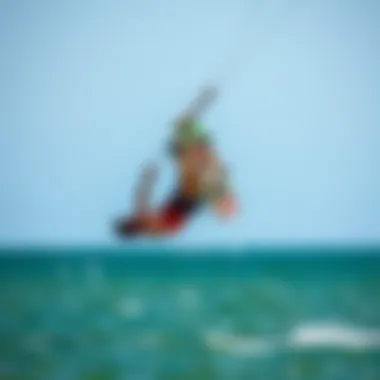
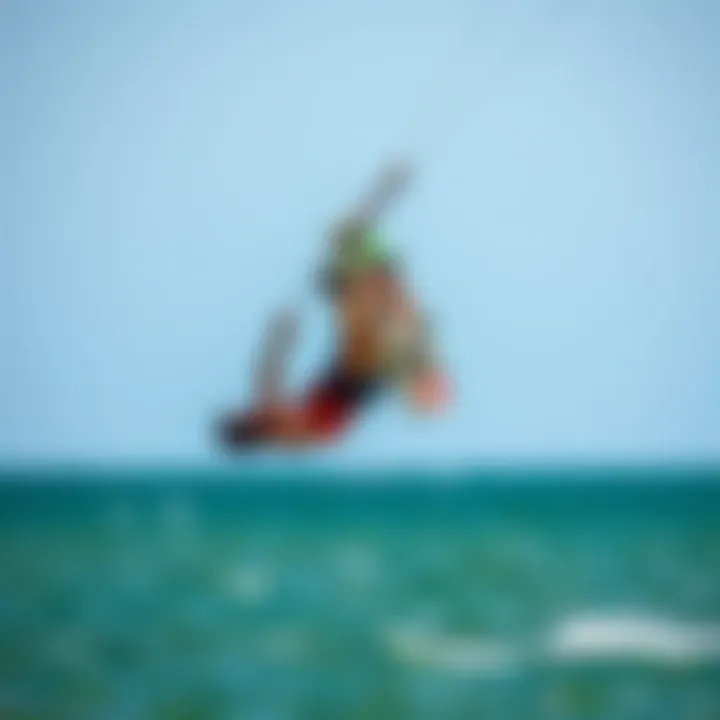
Intro
Kiteboarding, a sport that melds the thrill of surfing with the finesse of flying, offers countless opportunities for expression on the water. Among the many tricks that captivate onlookers and enhance a rider's repertoire, flips stand out as essential maneuvers that combine style and skill. Mastering flips not only boosts your kiteboarding resume but also provides a pathway to greater confidence and mastery over your equipment. Let's dive into the world of flips, exploring the vital elements that empower you to take your kiteboarding escapades to new heights.
Gear Selection
Choosing the right gear is pivotal, especially when aiming to perform flips effectively. The kite and board you select play a significant role in how well you execute these tricks.
Types of Kites
- C-kites: Known for their high power and excellent performance in freestyle tricks. Their shape allows for more lift, crucial for executing a flip.
- Bow kites: These offer a greater wind range and are more forgiving, making them an excellent option for those still honing their skills. They provide stable lift that can help during the transition phase of flips.
- Delta kites: Their unique design gives a mix of C-kite lift and Bow-kite stability. This blend allows for smooth takeoffs and landings, which is vital when practicing flips.
Selecting a kite based on personal riding style, wind conditions, and skill level is essential for maximizing performance.
Choosing the Right Board
The board is equally important and can drastically impact flips. Consider the following factors when selecting one:
- Size: A smaller board helps with quick movements but can be challenging in choppy water.
- Flex: Stiffer boards allow for better pop, while flexible ones provide more control for landing.
- Footstraps: Quality, adjustable footstraps ensure a secure fit, preventing unwanted slips during aerial maneuvers.
When you're equipped with the right kite and board, you're set to start perfecting those flips.
Skill Development
Acquiring the necessary skills for performing flips demands patience and practice. Understanding the techniques and progression is key to ensuring safety and success.
Essential Techniques
To initiate a flip:
- Start with a solid edge while heading upwind, maintaining speed.
- As you approach the ideal takeoff point, pull hard on the back hand to initiate pop.
- Tuck your knees into your chest as you rotate your body, keeping your eyes on your landing area.
- Extend your legs just before hitting the water to prepare for a smooth landing.
Mastering these steps takes time but pays off in the long run.
Progression Tips
Advancers often face hurdles; understanding common mistakes during flips is crucial:
- Over-rotation: Keep your body compact during the trick to maintain momentum.
- Under-rotation: Inadequate pop can lead to a tough landing. Learn to read wind conditions to adjust accordingly.
- Timing: Getting the timing right is essential for fluidity in flips; practice these maneuvers repeatedly to build muscle memory.
Flips can also be progressively challenging. Start with simpler variations, like an off-the-water flip, and gradually increase complexity as your confidence grows.
Learning from experienced kiteboarders through forums like Reddit's Kiteboarding community offers valuable insights. Also, consider watching tutorial videos on platforms such as YouTube that visually demonstrate these techniques.
Through understanding gear choices and enhancing skills, kiteboarders can cultivate a repertoire of flips, elevating their enjoyment and performance on the waves.
Understanding Flip Tips
Understanding flip tips in kiteboarding is fundamental for riders seeking to elevate their skills and enjoyment on the water. Flips represent a blend of style, technique, and skill, defining the bridge between beginner moves and advanced aerial maneuvers. They not only enhance the rider's repertoire but also provide a level of thrill and accomplishment that is hard to match. Riders have the opportunity to express their individuality through flips, making them a personal signature of one’s style. Mastery of flips can greatly enhance both confidence and performance, allowing kiteboarders to push the envelope of what can be achieved with every ride.
Defining a Flip
A flip in kiteboarding is broadly characterized as a rotational maneuver that involves the rider turning around an axis, typically horizontal, while airborne. This action can take various forms, ranging from simple rotations to complex hybrids involving spins and flips performed in combinations. To grasp the essence of a flip, it's essential to break down its components, including takeoff, rotation, and landing. These elements must work in harmony; even a slight miscalculation at any point can lead to less than desirable results. For instance, a rider may initiate a flip by generating enough height and speed, executing the necessary body position mid-air, and preparing for a stable landing.
Understanding the physics involved makes it clearer how speed, technique, and body mechanics come together. It’s both science and artistry, where the beauty of the move must be matched by execution. Whether it’s a back flip or a front flip, each variety carries its own nuances that riders should be aware of.
The Role of Flip Tips in Kiteboarding
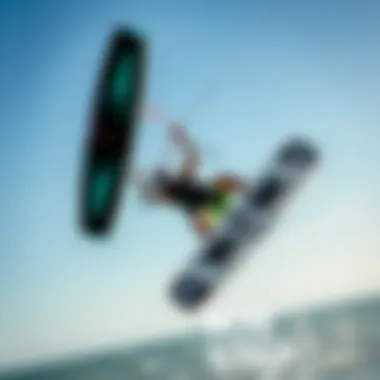
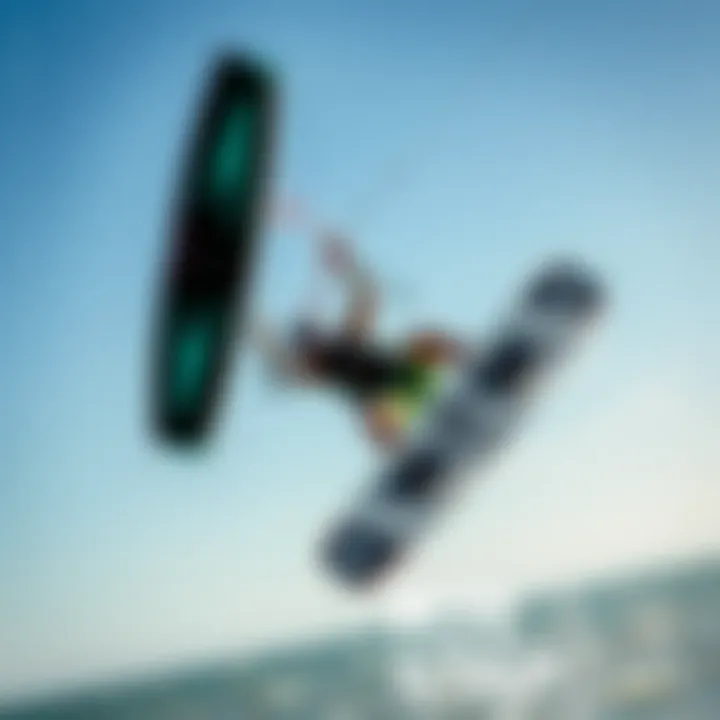
Flip tips are more than just performance enhancers; they transcend basic aerial maneuvers and reveal deeper layers of kiteboarding philosophy.
- Safety Aspect: Proper flip tips include strategies to minimize risk. Mistimed rotations can lead to hard landings; thus, emphasizing safe take-off and landing techniques is crucial.
- Skill Progression: Flips offer a natural pathway from fundamental skills to advanced techniques. Beginners often start with basic jumps and as they gain confidence, they incorporate flips into their practice.
- Style Expression: Each flip embodies a rider’s unique style. Selecting how flips are performed, speed, and body posture can differentiate one kiteboarder from another, turning every flip into an expression of the rider’s individuality.
- Community Interaction: Sharing tricks and tips on flips fosters camaraderie among kiteboarders. As they exchange experiences, they contribute to collective advancement in skills.
In essence, flip tips meld safety, skill-building, personal identity, and community. This combination provides a holistic approach to kiteboarding that encourages both physical prowess and emotional engagement with the sport. Understanding this role can directly influence how one approaches learning and executing flips, encouraging mindfulness and adaptability in one’s techniques.
"The art of kiteboarding lies in the flip: it's where passion meets performance."
As kiteboarders deepen their comprehension of flips, they not only refine their skills but also appreciate the sport on a more profound level.
Mechanical Aspects of Flips
Understanding the mechanical elements involved in executing a flip during kiteboarding is pivotal for a successful maneuver. The more adept you are at managing your body position, kite control, and timing, the more effectively you'll be able to perform flips. Not only do these skills contribute to your overall performance but they also enhance your safety and enjoyment out on the water.
Body Position and Balance
When preparing for a flip, getting your body position right is as crucial as your ability to steer the kite. Centering your weight plays a significant role here; if you lean too far back, you risk losing speed and control. On the flip side, if you lean too forward, you could face a hard landing.
To maintain balance during the maneuver:
- Keep your knees slightly bent. A flexible stance allows for better adjustments mid-flight.
- Engage your core; this stabilizes your movements and supports your overall posture.
- Align your shoulders and hips in the direction of rotation. This alignment fosters a more fluid transition during the flip.
Remember, a tiny shift in weight can translate into a vast difference in your performance. Finding that sweet spot takes practice, but once mastered, it can elevate your flips to a whole new level.
Kite Control During a Flip
The relationship between body movements and kite control cannot be overstated. As you initiate the flip, the kite must be correctly positioned to generate lift and power. The key to smooth kite control lies in keeping a constant tension on the lines. A well-timed upwards tug on the bar helps in creating the necessary lift.
Consider this guidance while controlling the kite:
- Keep the kite flying at a consistent height. It should ideally be around 10 to 12 o'clock for most flips.
- Use small, controlled inputs to adjust the kite's position instead of making big jerky movements. You want your kite's reaction to be predictable.
- If you feel you're losing control, don't hesitate to pull down on the bar to regain stability. This instinct can prevent unnecessary crashes and injuries.
The Importance of Timing
Timing is what separates a novice from a pro when performing flips. Precision in timing is not just about following a sequence; rather, it's about syncing your movements with the power generated by the kite. If you're late or early with your actions, the flip can either fail or lead to a bumpy landing.
Here’s how to nail your timing:
- Observe the kite's movements: Understand its trajectory and how it reacts under your control.
- Synchronize your take-off: As you pop off the water, that’s when the flip begins. If you hesitate, you may not generate enough lift.
- Practice counts: Repetition will help integrate muscle memory, making your timing feel natural.
“Good timing is as essential to kiteboarding as a good kite itself.”
For more information on kiteboarding techniques, you can check out resources from Wikipedia and Britannica. Engaging in forums such as Reddit and community boards can also provide valuable insights and peer support while you hone your craft.
Prerequisites for Performing Flips
Understanding the prerequisites for performing flips in kiteboarding is paramount. Flips are not just flashy tricks; they are technical maneuvers requiring well-honed skills and adept control of both body and kite. Before attempting complex rotations, it's vital to have a foundation that allows you to execute these moves safely and effectively.
Fundamental Skills
At the heart of successful flips lies a set of fundamental skills. These are the building blocks that every kiteboarder must master before taking on advanced tricks. First and foremost, kite flying skills are essential. A kiteboarder must be comfortable controlling the kite's power at various angles and harness the lift it provides. Having a firm grasp of basic maneuvers, such as jumps and turns, also lays the groundwork for executing flips. Practitioners should equally focus on balance and body positioning. Understanding how to shift weight while airborne can change the entire dynamic of a flip.
Moreover, practicing your water starts consistently ensures that you can easily engage with the kite after a flip attempt. Starting from a balanced position not only sets up the trick well, but it also supports a smoother landing. Proper posture on the board is crucial; a slight lean can mean the difference between a graceful flip and an unplanned dip into the water.
Remember: Every pro was once an amateur. This quote rings true in the world of kiteboarding. Mastering basics takes time but pays off immensely in the long run.
Gear Selection for Advanced Maneuvers
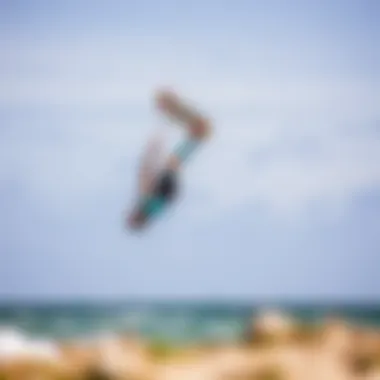
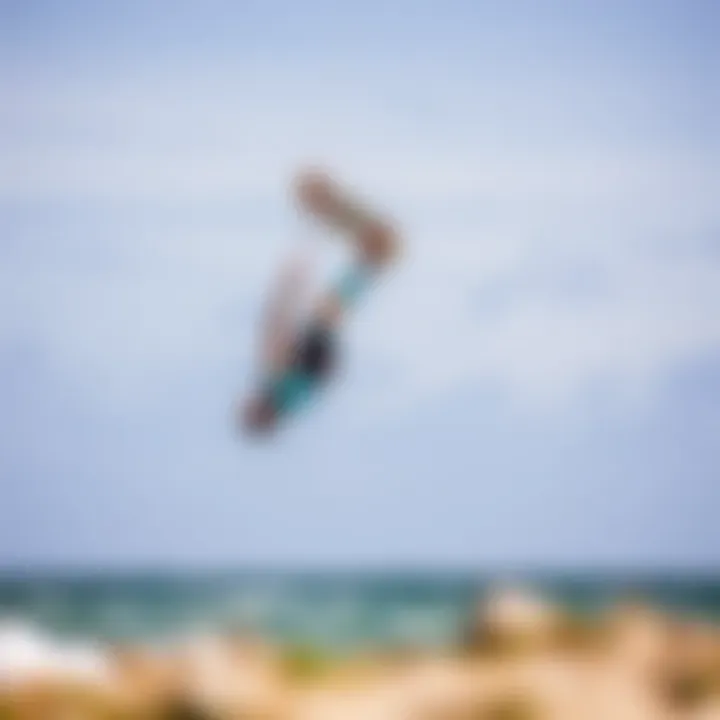
Equipping yourself with the right gear can also significantly impact your ability to perform flips. First things first, kite selection directly influences your performance; a kite with a strong lift and a predictable flight path is beneficial for beginners. Some models, like the Naish Pivot or Slingshot Rally, are designed to provide consistent performance during dynamic maneuvers. Additionally, the size of the kite plays a role. Larger kites (like a 12m) are suited for lighter winds, offering better lift, while smaller kites (like a 9m) excel in stronger conditions, which can make for crisp flips.
Your board choice shouldn’t be overlooked either. A lively board can give you that extra boost needed for a solid launch. Brands such as North Kiteboarding or Liquid Force provide boards that cater to versatile riding styles, helping you hone your flip technique effectively. You should also consider foot straps; those that are easy to adjust will ensure that your feet remain secure during the trick's execution.
Additionally, wearing appropriate safety gear, including helmets and impact vests, is often a good practice, especially when trying new tricks where falls are inevitable. Even if it may seem cumbersome at first, wearing the right protective gear minimizes the risk of injury when learning flips.
Common Mistakes When Attempting Flips
Learning flips in kiteboarding can feel like trying to juggle while riding a unicycle for many. It demands precision, timing, and an awareness of various factors in the environment. This is why identifying common mistakes is crucial. Riders often find themselves facing setbacks due to simple errors that could easily be avoided. By understanding these pitfalls, much progress can be made, enabling smoother transitions and more successful flips.
Over-rotation and Under-rotation
One of the trickiest aspects of flips in kiteboarding is mastering the rotation. Many beginners find themselves either over-rotating or under-rotating their tricks. Over-rotation can result in landing awkwardly or, worse, crashing into the water with little grace. This often happens because the rider fails to manage their speed or kite position adequately. For instance, pulling too hard on the back hand during the flip can send the kite higher, causing the board to rotate excessively.
On the other hand, under-rotation can leave riders feeling flat as they fail to complete the desired flip. Falling short on rotation can come from a lack of confidence in the maneuver, leading to a timid takeoff or insufficient kite lift. A good rule of thumb is to set a steady rotation speed while being aware of the kite’s position in the wind window.
Remember: A proper assessment of your takeoff angle can profoundly impact rotation. Do not rush the flip; take your time to gauge where you are in the air to better control the landing.
Inadequate Kite Power Management
Kite power management is another aspect often overlooked, yet it plays a vital role in executing flips. Riders frequently misjudge how much power they possess, which can lead to disastrous outcomes. For example, if the kite is too low in the window while taking off, it can steal power, making the flip inadequate. Conversely, having excessive power can lead to unwanted height, resulting in complications upon landing.
Riders should constantly check their kite's position relative to their takeoff point. A kite that’s slightly higher in the window can generate the additional lift needed for a successful flip. Balancing kite power, adjusting the speed before takeoff, and finding the sweet spot in the power zone are key to overcoming this challenge.
Insufficient Speed and Takeoff Angle
The takeoff angle and speed are also crucial elements when attempting flips. Many riders underestimate the importance of these factors, often leading to incomplete or sloppy flips. Insufficient speed can make a rider feel sluggish as they try to propel themselves into the rotation.
A common trap is to aim for a vertical takeoff, but this can cause unnecessary struggles. Instead, consider a more gradual takeoff angle. From a little distance, generating speed adequately allows the rider to engage in a more controlled flip. Think of it like setting a strong foundation for a house. If the base is weak, everything else is compromised.
Be prepared for some trial and error but remember, persistence is key. Adjusting your speed and approach angle according to wind conditions will smooth the journey towards mastering flips. Progress may come in increments, but paying attention to these common mistakes ensures a stable ride toward success.
Progression Techniques for Mastering Flips
Progression techniques are essential for anyone looking to master flips in kiteboarding. They serve as the building blocks, enabling practitioners to transition smoothly from basic to advanced maneuvers. Progression doesn't just enhance skills; it deepens understanding of kiteboarding's mechanics, leading to greater confidence on the water.
Learning flips begins with a solid foundation of skills and knowledge. It illustrates the necessity of breaking down complex moves into manageable steps. Mastery comes from patience and consistent practice, which these techniques promote. Whether you’re starting fresh or refining your technique, using established progression paths can make all the difference.
Starting with Basic Rotations
Starting with basic rotations is the first step in mastering flips. This approach is crucial, as it allows kiteboarders to gain comfort in the air while controlling their movements. A straightforward rotation, such as a 180-degree turn, offers immediate rewards while building muscle memory. The prime focus here is to familiarize oneself with the sensation of lifting off the water, spinning, and landing.
Practicing these simple rotations consistently can psychologically prepare one for more advanced flips later on. It is essential to cultivate a sense of timing and balance, both pivotal when transitioning to flips. Keep your movements light and fluid; this will aid in executing the rotations without feeling overwhelmed.
Using Progression Tools
Foam Pits
Foam pits are a unique and effective tool for those learning flips. These facilities create a safe landing environment, allowing kiteboarders to focus purely on their maneuvers without the fear of injury. The primary characteristic of foam pits is their depth and cushioning, enabling riders to practice various flips with minimal risk.
One beneficial aspect of foam pits is the ability to receive real-time feedback on one's technique without the immediate repercussions of landing in water. Additionally, they offer the chance to work on specific movements repeatedly. This feature is particularly advantageous for riders looking to refine their skills or conquer their fears.
However, it's crucial to note that practicing in a foam pit doesn't fully replicate the conditions of water. While it offers a safe environment, riders should eventually transition their practice back to water to adapt to the unique dynamics involved.
Water Ramp Systems
Water ramp systems present another innovative progression tool for mastering flips. These setups allow kiteboarders to launch themselves from a ramp into the air, facilitating higher jumps and extended airtime. A key aspect of water ramp systems is the ability to simulate real-world conditions closely. This similarity makes the transition from ramp to water seamless.
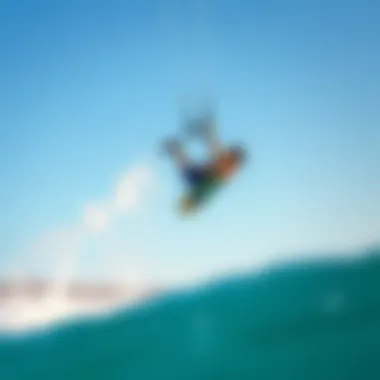
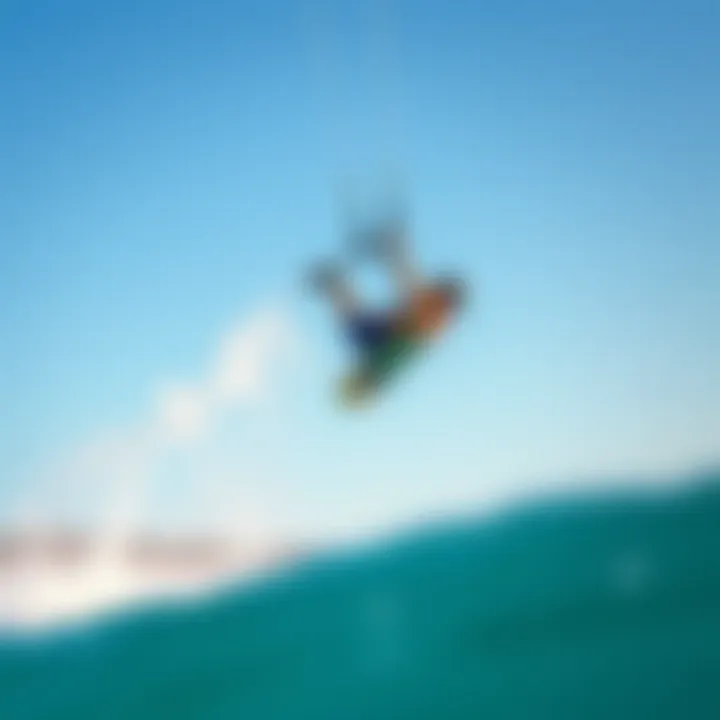
Not only does this method enhance aerial awareness, but it also provides crucial distance and height needed for mastering complicated flips. As riders take off, they can focus on their rotational movements without worrying about landing too harshly.
However, the specific setup and design can impact the experience significantly. Riders should familiarize themselves with the ramp's angle and surface to maximize their training efficiently.
Incremental Challenge Gradation
Progressing through incremental challenge gradation is vital for mastering flips. This method involves gradually increasing the difficulty of maneuvers while ensuring a solid grasp of each preceding level. By starting with simpler tricks and adding complexity step by step, riders can build their confidence effectively and reduce the risk of injury.
Enthusiasts often find themselves feeling overwhelmed when attempting advanced flips too quickly. Instead, focus on a gradual ascent where each level feels like a natural next step. Celebrate small victories along the way as they instill motivation to continue pushing oneself.
Additionally, engaging in structured progression techniques may help identify individual strengths and weaknesses, allowing for more personalized training approaches. Ultimately, the goal is to create a skill set robust enough to handle various flipping techniques seamlessly.
Safety Measures When Learning Flips
When venturing into flips during kiteboarding, safety should stand at the forefront of every rider's mind. Flips can be exhilarating, but they also come with their own set of risks. Understanding safety measures not only prevents accidents but also enhances the learning experience, allowing riders to push their limits with greater confidence and reduced anxiety. Let's break down some crucial elements that should never be overlooked when tackling flips.
Protective Gear Essentials
Equiping oneself with the right protective gear is paramount in kiteboarding flips. A helmet is non-negotiable—it's essential to protect the noggin against unexpected falls or miscalculations. Likewise, impact vests serve as a buffer during landings, absorbing some of the shock and providing flotation when you find yourself in the water. Beyond these, kiteboarding shoes can offer grip and protection to your feet, shielding them from sharp or rough objects below. Here’s a quick checklist of essentials for your kiteboarding gear:
- Helmet: Should fit snugly without being too tight.
- Impact Vest: Provides both protection and flotation.
- Kiteboarding Shoes: Helps with grip and foot safety.
- Wetsuit: For warmth and additional protection against falls.
Using this gear can significantly reduce the risks associated with attempting flips. Not wearing protective gear is like sailing without a life jacket—risky business!
Buddy Systems and Supervision
Learning flips alone can be a recipe for disaster. Having a buddy system in place is highly advisable. Not only does having a mate around ensure there's someone to help in case things go sideways, it also promotes a safer environment. Your buddy can assist with spotting potential dangers, assist in landing, and even provide feedback on your technique. There’s wisdom in the old adage: "Two heads are better than one."
This is how you can implement a buddy system effectively:
- Supervised Practice: Always have someone to keep an eye on you.
- Communicate Clearly: Set signals or codes to communicate intentions.
- Support Each Other: Help each other identify mistakes and correct them.
Benefits of this system extend beyond mere safety; it can make the whole learning process more enjoyable and supportive.
Evaluating Water Conditions
Understanding your environment can't be overstated; conditions on the water play a key role in your safety level when learning flips. Each spot has its own unique attributes, such as currents, depth, and wind patterns. Before launching into your flip practice, take a moment to gauge the water conditions thoroughly. Here are some vital points to consider:
- Water Depth: Ensure there's enough depth to avoid hitting the bottom during falls.
- Wind Speed: Calm days are preferable; excessive wind can make control challenging.
- Obstacles: Survey the area for any submerged objects or other hazards.
By learning to assess these conditions, you arm yourself with the knowledge needed to make informed decisions about when and where to practice flips. Adapting to the environment can make all the difference in ensuring a safe experience.
"Safety doesn’t happen by accident; it’s built on awareness and preparation."
In summary, while the thrill of flips can be tempting, approaching them without proper precautions can have dire consequences. By using protective gear, sticking with a buddy, and keeping an eye on water conditions, you'll not only stay safe but also enjoy the learning journey.
The End and Further Considerations
Mastering flips in kiteboarding is not just a series of maneuvers; it’s a journey that reflects the essence of growth and adventure on the water. As we draw this guide to a close, it’s essential to think about the broader implications of the skills acquired and how they can shape one’s kiteboarding experience.
Reflecting on Progress
Looking back at your progress, it’s important to appreciate the strides you’ve made in your ability to perform flips. Take a moment to assess your current level compared to where you began. This reflection is key—not only does it help you identify areas for improvement, but it also reinforces your commitment to the craft. Capturing these moments, perhaps through videos or journaling, can create a tangible record of your journey. This is not just about flips; it’s about recognizing that every small victory builds confidence and ultimately leads to greater accomplishments.
Long-Term Commitment to Skill Development
Flip tips require steady dedication. Kiteboarding, like any sophisticated sport, demands an ongoing willingness to learn and adapt. When you step onto the water, think of each session as a chance to refine your technique, whether you are experimenting with new approaches or honing established skills. Embrace the necessity for continuous learning—join clinics, workshops, or local meetups to exchange knowledge with others. This commitment not only enhances your abilities but also allows for a richer experience, forging connections that extend beyond flips alone.
Engaging with the Kiteboarding Community
Being part of a community can significantly elevate your learning curve. Engaging with fellow kiteboarders offers the dual benefit of support and motivation. Share your experiences, challenges, and triumphs. Participate in events, both competitive and social, to immerse yourself in a community that shares your passion. Online forums such as Reddit and Facebook group discussions can also be invaluable; they can provide insights and advice tailored to your specific needs. You’ll find that exchanging stories and tips not only backfills your knowledge but also forges lifelong friendships, making the journey of mastering flips all the more rewarding.
Flip tips aren't merely technical tricks—they’re gateways to confidence and camaraderie within the kiteboarding realm. Take these considerations to heart as you continue your journey, knowing that each flip you master is a testament to your determination and love for the sport.















